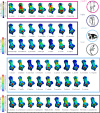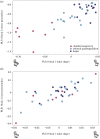Inferring locomotor behaviours in Miocene New World monkeys using finite element analysis, geometric morphometrics and machine-learning classification techniques applied to talar morphology
- PMID: 30257926
- PMCID: PMC6170775
- DOI: 10.1098/rsif.2018.0520
Inferring locomotor behaviours in Miocene New World monkeys using finite element analysis, geometric morphometrics and machine-learning classification techniques applied to talar morphology
Abstract
The talus is one of the most commonly preserved post-cranial elements in the platyrrhine fossil record. Talar morphology can provide information about postural adaptations because it is the anatomical structure responsible for transmitting body mass forces from the leg to the foot. The aim of this study is to test whether the locomotor behaviour of fossil Miocene platyrrhines could be inferred from their talus morphology. The extant sample was classified into three different locomotor categories and then talar strength was compared using finite-element analysis. Geometric morphometrics were used to quantify talar shape and to assess its association with biomechanical strength. Finally, several machine-learning (ML) algorithms were trained using both the biomechanical and morphometric data from the extant taxa to infer the possible locomotor behaviour of the Miocene fossil sample. The obtained results show that the different locomotor categories are distinguishable using either biomechanical or morphometric data. The ML algorithms categorized most of the fossil sample as arboreal quadrupeds. This study has shown that a combined approach can contribute to the understanding of platyrrhine talar morphology and its relationship with locomotion. This approach is likely to be beneficial for determining the locomotor habits in other fossil taxa.
Keywords: Platyrrhini; finite-element modelling; morphometrics; positional behaviour; statistical learning; talus.
© 2018 The Authors.
Conflict of interest statement
We have no competing interests.
Figures








Similar articles
-
The evolution of the platyrrhine talus: A comparative analysis of the phenetic affinities of the Miocene platyrrhines with their modern relatives.J Hum Evol. 2017 Oct;111:179-201. doi: 10.1016/j.jhevol.2017.07.015. Epub 2017 Aug 29. J Hum Evol. 2017. PMID: 28874270 Free PMC article.
-
A Dryopithecine Talus From Abocador de Can Mata (Vallès-Penedès Basin, NE Iberian Peninsula): Morphometric Affinities and Evolutionary Implications for Hominoid Locomotion.Am J Biol Anthropol. 2025 Apr;186(4):e70043. doi: 10.1002/ajpa.70043. Am J Biol Anthropol. 2025. PMID: 40202193
-
Biogeography in deep time - What do phylogenetics, geology, and paleoclimate tell us about early platyrrhine evolution?Mol Phylogenet Evol. 2015 Jan;82 Pt B:358-74. doi: 10.1016/j.ympev.2013.12.002. Epub 2013 Dec 12. Mol Phylogenet Evol. 2015. PMID: 24333920
-
Locomotor diversification in new world monkeys: running, climbing, or clawing along evolutionary branches.Anat Rec (Hoboken). 2011 Dec;294(12):1991-2012. doi: 10.1002/ar.21508. Epub 2011 Nov 1. Anat Rec (Hoboken). 2011. PMID: 22042747 Review.
-
Functional morphological similarities in the locomotor skeleton of miocene catarrhines and platyrrhine monkeys.Folia Primatol (Basel). 1996;66(1-4):7-14. doi: 10.1159/000157180. Folia Primatol (Basel). 1996. PMID: 8953745 Review.
Cited by
-
Application of artificially intelligent systems for the identification of discrete fossiliferous levels.PeerJ. 2020 Mar 11;8:e8767. doi: 10.7717/peerj.8767. eCollection 2020. PeerJ. 2020. PMID: 32201651 Free PMC article.
-
The first Miocene fossils from coastal woodlands in the southern East African Rift.iScience. 2023 Aug 15;26(9):107644. doi: 10.1016/j.isci.2023.107644. eCollection 2023 Sep 15. iScience. 2023. PMID: 37701811 Free PMC article.
-
Hide and seek shark teeth in Random Forests: machine learning applied to Scyliorhinus canicula populations.PeerJ. 2022 Jul 4;10:e13575. doi: 10.7717/peerj.13575. eCollection 2022. PeerJ. 2022. PMID: 35811817 Free PMC article.
-
From beasts to bytes: Revolutionizing zoological research with artificial intelligence.Zool Res. 2023 Nov 18;44(6):1115-1131. doi: 10.24272/j.issn.2095-8137.2023.263. Zool Res. 2023. PMID: 37933101 Free PMC article. Review.
-
Endostructural and periosteal growth of the human humerus.Anat Rec (Hoboken). 2023 Jan;306(1):60-78. doi: 10.1002/ar.25048. Epub 2022 Aug 25. Anat Rec (Hoboken). 2023. PMID: 36054304 Free PMC article.
References
-
- Fleagle JG. 2013. Primate adaptation and evolution, 3rd edn San Diego, CA: Academic Press.
-
- Tejedor MF. 2008. The origin and evolution of neotropical primates. Arq. Mus. Nac. Rio Jan. 66, 251–269.
-
- Tejedor MF. 2005. New specimens of Soriacebus adrianae Fleagle, 1990, with comments on pitheciin primates from the Miocene of Patagonia. Ameghiniana 42, 249–251.
Publication types
MeSH terms
LinkOut - more resources
Full Text Sources
Other Literature Sources

